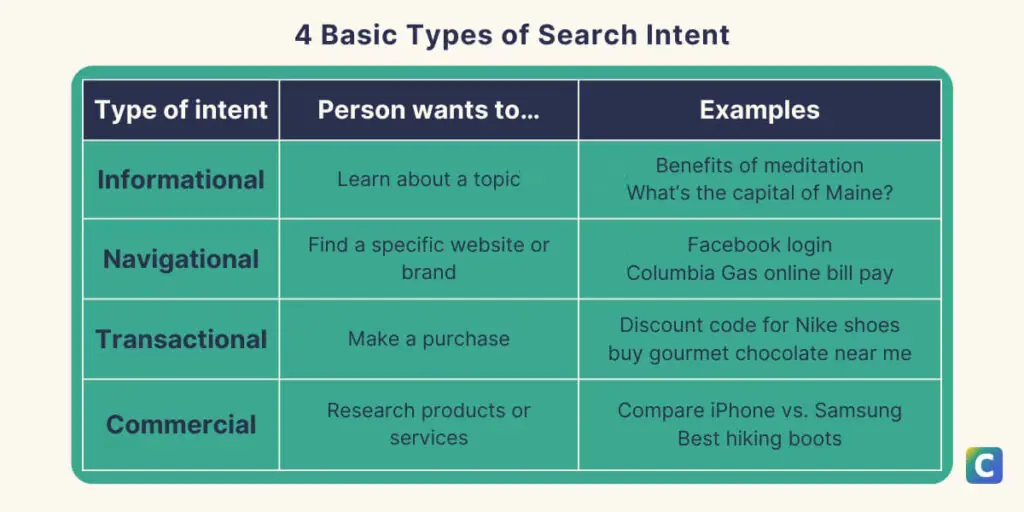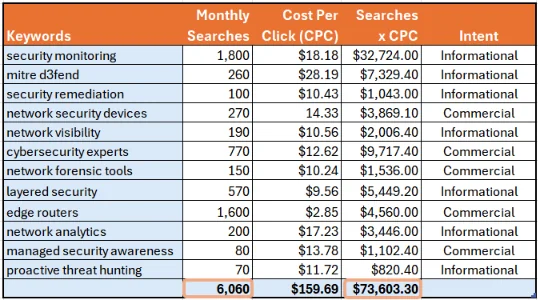Let’s talk cold, hard cash. Just how much is that coveted first-page ranking on Google worth?
It’s a bit like having a really good Hollywood agent — it won’t guarantee success, but it sure makes everything else easier.
So, how do you rank #1?
For starters, don’t waste people’s time
You already know Google search rankings matter because a page one appearance brings you traffic, conversions, and authority.
But it’s not just about being visible; it’s about being valuable. In other words, throwing keywords around like confetti is no longer enough to put you ahead of titans like Amazon, Apple, or even Atlanta’s top lawyer in a Google race-to-the-top. Certain search terms are skewed towards visitors clicking on higher ranked positions.
The secret? It’s all about creating content that’s actually useful. When deciding which keywords and phrases to target, you need to think about your visitors’ search intent — what people actually want, not what you think they want. And to do that, you need to know them.
Basically, there are two types of visitors:
- Those who are in the market to buy something.
- Those who are just looking for information.
The ones with commercial or transactional intent (the first group) are more likely to turn into leads since they’re already pre-qualified. So, you should prioritize your keywords around this group.

Clearscope, 2024
Next, you’ve got to “get” Google
The search engine ranking page (SERP) has come a long way from the coveted list of 10 blue links. These days, Google emphasizes visual, easily excerpted, up-to-date content that delivers quick answers.
“Getting Google right” means being a bit of an octopus and keeping an eye on several spinning plates at a time. For starters, getting onto the first page doesn’t guarantee you a click. In fact, as of 2024, nearly 60% of Google searches end without a click, up from around 50% in 2019.
The rise in this “zero-click” phenomenon is a direct result of features like AI Overviews, Featured Snippets, Knowledge Panels, and Direct Answers.
With AI Overviews, if a visitor’s search intent is in any way informational in nature, like asking why, how, or who, the AI response will dominate the first page, pushing all other organic results well below the user’s sightline.
Last, you need an SEO sherpa to lead you to the top
For the record, there are plenty of Google ranking experts out there, and everyone has their own unique organic search forecasting model.
Ours has been proven successful for small and midsize businesses, and it’s a recipe that’s been perfected over the past 10+ years of algorithm updates — although you’ll still find us tinkering with it. Here, I’ll walk you through some of the variables that factor into our approach.
Of course, your unique business, industry, and competitive factors will all influence how a forecast is built.
Variable #1 | How to Rank Higher on Google in 2025? Prioritize Google
It really is all about Google, isn’t it? Even with a slight dip (when we checked last December), their search engine market share still took up a lion’s share of 89.74%. The competitors are still far behind:
- Notwithstanding their Copilot big bang, Bing in 2024 only captured a measly 3.97%.
- Yahoo, Baidu, Yandex, and DuckDuckGo registered a 5.32% share combined.
- And coming up fast, but still barely noticeable, are the AI chatbots behaving like search engines.

Search Engine Market Share, StatCounter, December 2024
So, unless search engine rankings change drastically in the first half of 2025, the smart money is on continuing to optimize for Google’s first page. Do that and you can rest assured the other search engines will follow Google’s lead.
HOT TIP: As you begin your website optimization strategy, know where you are in space. Are you selling designer handbags or industrial waste containers? Google will assign values differently for different industries. It’s like asking how much a slice of pizza is worth in New York versus in the middle of the Sahara Desert. The real click-through rates can look very different depending on your keyword environment and your industry.
Variable #2 | With Click-Through Rates, it’s Winner Take All
It’s not hard. Click-through rates (CTRs) determine how much money you’re going to make, plain and simple. High click-through rates translate directly to higher lead generation and conversion opportunities. That’s because first-page rankings not only drive more traffic but also establish trust and credibility with potential customers. This creates a virtuous cycle of more visitors, more clicks, and more conversions.
Here’s why it pays to be number one:
- Generally, the top spot of Google’s organic search rankings gets an average of 39.8% of all the clicks from the first page.
- Second place? Around 18.7% — still cool, but more like the kid who peaked in high school.
- Third place, about 10.2%.
- If you’re in fourth, you can expect around 7.2%.
- Fifth generally delivers 5.1%.
By the time you hit tenth place, you’re getting a sad 1.6%.
Oh, does your website actually show up somewhere on the second page? Forget it, you may as well be invisible.

Snoop Dogg Come Again, Tenor
HOT TIP: The first page of Google receives 92% of all search traffic, while the second page experiences a dramatic drop to just 5%. Only 0.78% of users even make it to page two. You know where you want to be.
Variable #3 | Conversion Rates Transform Traffic into Cold, Hard Cash
Here’s where the rubber meets the road. When a user searches, finds you on page one, clicks the link to your website, discovers exactly what they were looking for, and then purchases your product – that’s amore. It’s also a conversion. (Filling out a form and entering your lead funnel counts, too.)
Depending on the industry and channel, of course, the average SEO conversion rate across all page types is 2.4%.
To calculate an SEO conversion rate, divide the number of conversions (whatever the desired action is for your website, like a purchase, a demo request, a download etc.) by the total number of visitors to your website, then multiply the result by 100 to express it as a percentage.
So, if your website receives 7,500 visitors in a month and 150 of those visitors made a purchase, your SEO conversion rate would be calculated as follows:
(150 conversions / 7,500 visitors) * 100 = 2%
Variable #4 | Pick Keywords and Phrases that Target Buyers (Not Window Shoppers)
To catch the right fish, you need the right bait. In SEO-speak, that means that the keywords you’ll want to target depend on the types of visitors you want to attract.
Take a look at the list below. Those typing “network forensic tools” aren’t writing a report on cybersecurity. They’re looking for options to buy. It is best to be specific when trying to catch this particular brand of visitor and not focus on generalized terms like “security monitoring” alone.
The Cost Per Click (CPC) in our table is the price an advertiser would pay for each click to their Google paid ad. The more popular a keyword, the higher the CPC.
HOT TIP: The click-through rate for paid ads vs. organic results is significantly less. Where the #1 organic result has a 39.8% CTR, the #1 paid ad might only reach 2.1%. It seems searchers consider organic results more trustworthy.

TheOAG SEO research
Variable #5 | Calculate the Value of a Higher Google Ranking
Now, for the math. (You knew it was coming). To estimate how much you stand to gain in revenue from a higher Google ranking, do the following:
- Identify the Total Monthly Searches. This denotes the total number of searches for selected keywords per month.
- In this case, it’s 6,060 from the above table.
- Multiply that by the Click Through Rate for your Position.
- In Variable #2, we told you the top spot of Google’s organic search rankings gets an average of 39.8% clicks (we’re assuming you got the #1 position for each keyword).
- Multiply that by the Conversion Rate.
- In Variable #3, we said the average SEO conversion rate is 2.4%.
- Multiply that by your Average Customer Spend.
- In this case, we’ve made an assumption that your customer spends an average of $500 per month for your products/services.
So, when we string it all together, we have:
- 6,060 total searches for the selected keywords
- 39.8% CTR for the #1 Position
- 2.4% conversion rate
- $500 average customer value
That looks like:
⭐Potential monthly revenue: 6,060 x 0.398 x 0.024 x $500 = $28,942.56
⭐Potential annual revenue: 6,060 x 0.398 x 0.024 x $500 x 12 = $347,310.72
Referring back to our keyword table, you can see that the return on investment for organic vs. paid ads is significant. Paid ads might get you quick wins, but people who find you through organic search are more likely to become customers and give you better value for money in the long run.
HOT TIP: If you don’t know how to estimate traffic from your keywords to begin with, that’s where SEO experts like us can help. Don’t worry – it’s a brand-new world for a lot of small businesses. We can help you catch up and start running with the pack. And then, we’ll shoot you clear ahead.
The End Game: Being the Most Popular Kid on the Internet
Organic search should ultimately be a leading source of traffic to your website, whether your goal is to acquire leads, secure sales, or build brand affinity. But being on Google’s first page isn’t just about traffic and money. It’s about becoming the envy of the internet world. You’re not just popular; you’re influencing social media engagement, encouraging offline conversions and attracting business opportunities. You’re building your brand.
But here’s something the other articles about ranking won’t tell you: rankings are like fine wine – they get better with age. The longer you stay on that first page, the more value you accumulate. It’s like compound interest, and in addition to generating money, you’re banking trust and authority. Before you know it, you’re the Betty White of websites – beloved, trusted, and seemingly immortal.





